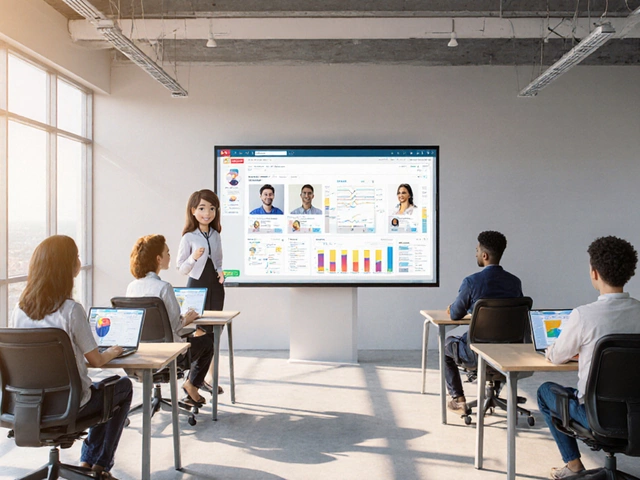
In the ever-evolving world of education, three letters have become particularly significant: LMS. But what does LMS stand for and why is it important? At its core, LMS—or Learning Management System—is a powerful tool used to plan, deliver, and manage learning experiences. In today's digital age, where education is becoming increasingly accessible online, LMS plays a pivotal role.
Unlike traditional classroom settings, LMS offers flexibility that benefits both students and educators. It enables a self-paced learning environment where resources are readily accessible, and communication extends beyond the confines of physical walls. As we step further into the digital era, understanding LMS and its applications becomes essential for anyone involved in education or training.
- Introduction to LMS
- Key Features of LMS
- Benefits of Using LMS
- Common Misconceptions
- Future of LMS in Education
Introduction to LMS
LMS, or Learning Management System, might initially seem like just another tech acronym floating around in the universe of online education, but its significance is immense. The main aim of an LMS is to enhance the learning process by offering an integrated platform where educational materials, assignments, discussions, quizzes, and tracking features are all available in one place. This technology dates back to the early 2000s, aligning with the rapid growth of the internet and online education. As digital learning platforms started gaining momentum, the demand for organized and efficient systems became crucial, thus paving the way for the development of LMS.
The flexibility offered by LMS is evident in its adaptability, as it caters to various educational environments including schools, colleges, and corporate training centers. A striking feature of LMS is how it centralizes data management. Students, educators, and administrators get seamless access to course materials, grades, and analytics without having to sift through multiple applications or platforms. According to a report by Research and Markets, the global LMS market is projected to reach $22.4 billion by 2028, highlighting its critical role in the evolution of e-learning. This growth is a testament to the efficiency and convenience LMS brings to modern education.
When discussing LMS, it's important to consider its layered architecture which allows the integration of different multimedia elements to enrich educational content. This means video lectures, interactive sessions, and digital textbooks can all coexist, offering a richer learning experience. In an LMS, learners were found to be 60% more engaged in courses compared to traditional settings, according to a study by the eLearning Industry. The use of multimedia and interactive elements keeps learners motivated and makes complex subjects easier to understand.
"The beauty of LMS lies in its ability to personalize learning. Every student learns differently, and LMS offers the tools to cater to these varying needs," shares Linda Wilson, a reputable digital education consultant.
Introducing LMS into an educational framework does not only improve learning outcomes but also reduces administrative burdens. It automates daily processes such as grading, tracking attendance, and updating course materials, freeing educators to focus more on actual teaching and student engagement. Moreover, LMS is a great equalizer, bridging geographical gaps by offering quality education regardless of location. Whether you are in bustling Nairobi or a remote village, with LMS, high-quality education is just a click away. Users can log into these systems at any time, reflecting the shift towards a more learner-centered approach where individuals take control of their educational journey.
Key Features of LMS
When diving into the world of LMS, or Learning Management Systems, it is crucial to recognize their distinctive features that set them apart from other educational tools. An integral component of any effective e-learning platform is its ability to streamline course content, a task suited perfectly to the nature of an LMS. These systems often come with a comprehensive course management unit, where educators can organize materials, create syllabi, and outline learning objectives with ease.
One key aspect that enhances the LMS experience is its versatile assessment functionalities. Modern systems provide a range of options for creating quizzes, assignments, and exams tailored to different learning styles and subjects. This adaptability ensures that students engage with the material in a manner that resonates best with them. In addition, LMS allows for automatic grading and feedback, saving educators valuable time and enabling prompt responses to students’ needs. As education strategist Ryan Tracey once said,
"An LMS is not just a tool but a digital lifeline for both educators and learners, connecting goals with achievable outcomes."
Another noteworthy feature is the collaborative tools offered by LMS. Interaction is vital to the learning process, and these systems foster it through forums, discussion boards, and group projects. Students can communicate with their peers and instructors beyond the classroom, breaking geographical barriers. The potential for cross-cultural exchange and global learning experiences is immense, paving the way for a richer educational environment. Moreover, integration with external tools like Zoom or Google Classroom enhances these interactions, making learning more dynamic and engaging.
Personalization and Customization
Personalization is a buzzword in education today, and LMS delivers in spades. It empowers educators to tailor courses to the unique needs and learning paces of students. This customization extends to the user interface, allowing teachers and administrators to adapt the system’s appearance and functionality to best fit the institution's brand and educational focus. For instance, the reporting capabilities in an LMS provide valuable insights into student engagement and performance, aiding educators in identifying trends and areas for improvement. By customizing dashboards, educators can track progress and fine-tune their teaching strategies effectively.
In terms of statistical data, consider the integration of analytics where LMS potentially tracks hundreds of student data points. A report by Ambient Insight highlights that the global LMS market is expected to reach $22.4 billion by 2023, a testament to its growing importance in education. This data-driven approach ensures that both instructors and learners benefit from actionable insights, transforming raw data into a roadmap for future learning endeavors.
- Course and content management
- Assessment and grading automation
- Collaborative tools
- User personalization
- Data analytics and reporting
As schools and organizations increasingly embrace digital learning, understanding these basic yet critical features of an LMS becomes essential for a successful implementation. After all, an LMS isn't just about managing learning; it's about revolutionizing it, making education accessible, inclusive, and adaptable to the ever-evolving needs of modern society.

Benefits of Using LMS
Embracing a Learning Management System (LMS) brings with it a multitude of advantages that revolutionize education and training methodologies. One of the most prominent benefits is the flexibility it offers. Unlike traditional educational frameworks, LMS enables learners to access course materials at their own pace and on their own schedule. This flexibility is especially crucial in today's busy world where students and professionals juggle various responsibilities. By allowing learners to customize their learning schedules, LMS empowers them to integrate education seamlessly into their daily lives, promoting a more engaging learning experience.
LMS also enhances accessibility to education. With geographical boundaries no longer a limitation, anyone with an internet connection can participate in educational courses globally. This opens doors for students in remote and underprivileged areas to access quality learning resources, leveling the playing field. Teachers and institutions offering courses through LMS can reach a wider audience, expanding their impact and influence in the educational realm. Moreover, LMS platforms often support multiple languages, breaking down language barriers and fostering a more inclusive and diverse learning environment.
Another substantial benefit lies in the centralized platform LMS offers for managing educational content. Teachers and administrators can gather learning resources, assessments, and data analytics in one location, streamlining content delivery and student management. This centralization facilitates easier tracking of student progress and performance. Educators can quickly identify areas where students excel or struggle, enabling them to tailor their teaching strategies and provide personalized support. With tools to manage and store learning materials efficiently, educational institutions can significantly reduce administrative overhead, saving both time and resources.
The integration of innovative technologies such as artificial intelligence and machine learning is rapidly transforming the traditional education landscape. LMS platforms can incorporate adaptive learning technologies that personalize learning experiences based on individual student needs, preferences, and performance. This personalized approach ensures that no two students receive the same learning path, enhancing engagement and retention of knowledge.
According to a report by the Educational Technology Research Institute, adaptive learning technologies have led to a 20% improvement in student performance across various disciplines.Such enhancements in teaching methods resonate in both student satisfaction and educational outcomes, making LMS a critical component for progressive academic environments.
The analytics capabilities embedded within LMS platforms offer invaluable insights for educators and institutions. LMS can track a wide variety of metrics, from student login frequencies to assessment scores, providing educators with real-time feedback on course effectiveness. This data-driven approach enables ongoing optimization and refinement of curricula, directly contributing to enhanced learning outcomes. For organizations, this translates to valuable insights that can inform strategic decision-making in terms of curriculum development, teaching strategies, and resource allocation.
Common Misconceptions
When it comes to learning management systems, there's no shortage of assumptions and misconceptions that can cloud our understanding of its true purpose and potential. One frequent misunderstanding is that LMS is merely a digital repository for coursework. While it's true that LMS platforms store a wealth of knowledge, they are far more intricate than just virtual filing cabinets. A robust LMS is interactive, facilitating not only content delivery but also engaging communication between educators and students. It offers tools for assessments, discussions, and feedback, all of which contribute significantly to the learning process.
Another prevailing myth is that integrating an LMS is a cumbersome endeavor that requires extensive technical acumen. While initial setup can be demanding, most modern e-learning systems boast user-friendly interfaces designed to minimize complexity. With step-by-step support and tutorials, educators with minimal technical expertise can effectively navigate these platforms. It's important to recognize that many LMS solutions come as cloud-based services, reducing onsite maintenance and updates significantly.
Perceived Limitations and Myths
A common notion is that an LMS lacks the personal touch of face-to-face interactions. Some argue that digital learning environments cannot cultivate the same rapport between students and instructors. However, as technology progresses, LMS platforms are incorporating diverse tools for enhanced interaction such as video conferencing and discussion forums. These features endeavor to replicate classroom dynamics in a virtual space, fostering an educational experience that's both personal and interactive.
"Adopting an LMS doesn't mean a loss of human interaction; it's a shift to a different kind of engagement where technology enhances connection in meaningful ways," says Dr. Emily Chen, an expert in digital education.
Lastly, there's a myth that LMS solutions are solely for educational institutions. In reality, these systems are invaluable assets in workplace training and corporate learning as well. Corporations employ LMS to upskill employees, as it provides a structured yet flexible mode of learning for professionals. To dispel these misconceptions, we must view LMS as a transformative tool beyond the confines of traditional education. It's about weaving technology into the fabric of learning, creating an immersive and accessible experience across various domains.

Future of LMS in Education
As we stand on the brink of a new era in education, the role of LMS in transforming the way we learn and teach is becoming ever more significant. The future of Learning Management Systems is not just about enhancing digital learning; it's about reimagining the entire educational landscape. Technology continues to advance at a tremendous pace, and LMS platforms are expected to integrate with emerging technologies, making education more engaging and accessible.
One significant trend in the future of LMS is the incorporation of artificial intelligence. AI can personalize the learning experience by analyzing student data to adjust the pace and style of teaching according to individual needs. This not only helps in identifying areas where students struggle but also predicts potential challenges before they arise. A report by EDUCAUSE noted that AI-driven LMS could increase student engagement by adapting course material in real-time.
According to Tom Vander Ark, an expert in education technology, "LMS will soon be more than a classroom tool; they will evolve into platforms for lifelong learning, supporting skills development from childhood through the workforce."
E-learning platforms are also expected to leverage virtual reality (VR) and augmented reality (AR) to create immersive learning environments. Imagine students exploring ancient ruins in history classes or conducting complex science experiments through VR goggles. Such experiences not only make learning more interactive but also provide practical insights which are sometimes difficult to attain in a traditional setting.
Another exciting development on the horizon is the integration of blockchain for credentialing. This technology offers a new way to verify and share educational achievements securely. Each certificate issued by an institution can be permanently recorded on a blockchain, ensuring authenticity and trust. Such verification is becoming crucial in a world where education is increasingly online and global.
Moreover, the rise of mobile technology will continue to influence the future of LMS, providing students the ability to learn on-the-go. Mobile-friendly LMS systems make education accessible anywhere, anytime, breaking barriers of geography and time. According to a study done by Cisco, it is estimated that by 2026, over half of the world's population will be connected to the internet through mobile devices, making mobile-compatible LMS vital.
Conclusion
The future of LMS in education looks incredibly promising. These platforms are set to revolutionize the way knowledge is disseminated, making it more personalized, secure, and engaging. As institutions worldwide increasingly adopt LMS technology, the dream of making quality education accessible to all is becoming a reality. Integral to this is the ongoing innovation and adaptation of LMS in addressing educational needs and broadening horizons beyond traditional borders.







